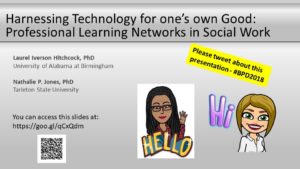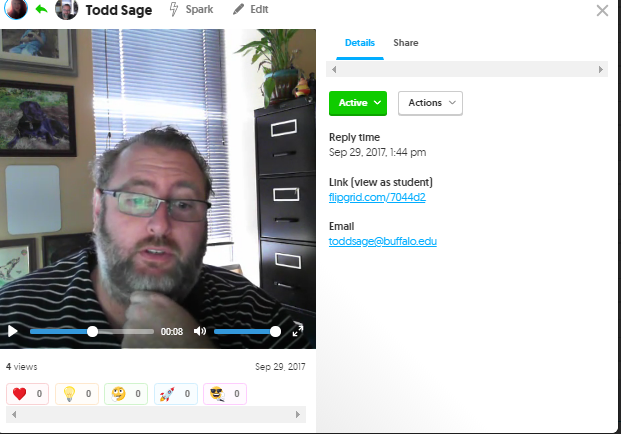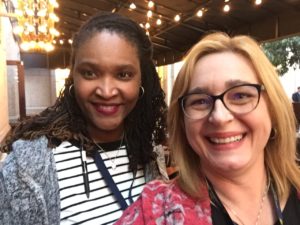Incorporating Flipgrid into the Social Work Classroom: Tips for #SocWorkEd
Todd Sage is a social work educator at the University at Buffalo, and a Doctoral Student in Teaching and Learning: Higher Education at the University of North Dakota. In this blog post, he shares his tips for educators on how to use Flipgrid to enhance online learning and develop class community. Todd can be reached at ToddSage@Buffalo.edu. Follow him on Twitter: @socialworksage.
In 2017, new National Association of Social Workers’ Standards for Technology in Social Work Practice were issued to address the intersections of social work practice and technology. These standards encourage educators to equip social work students with technology skills that will prepare them for tech-mediated practice. Student exposure to classroom technology primarily happens through Learning Management Systems such as Blackboard and Adobe Connect, which can be useful tools for online teaching, but are geared for educational users are rarely used in the practice world.
To prepare the next generation of social workers, it is vital that social work educators inform students about readily available collaboration platforms that are transferable to real world practice. It gives students an opportunity to learn a new tool, evaluate its pros and cons, and think about how these tools can be applied to future practice. On some occasions, the tools also work much better than institutional platforms.
When I taught Motivational Interviewing last term in a primarily asynchronous setting, I didn’t know how I would use the existing institutional tools to teach interview skills. This is why I was happy to find Flipgrid. This platform works like a discussion board, only all the content is short video clips, and the desktop and phone-app platforms are so easy to use that even kindergarten teachers have students create videos.
What is Flipgrid? Flipgrid describes their website as one “… that allows teachers to create “grids” of short discussion-style questions that students respond to through recorded videos. Each grid is effectively a message board where teachers can pose a question and their students can post 90-second video responses that appear in a tiled “grid” display”(Flipgrid, n.d).
Three things I learned at #IPECSpring18
 About two weeks ago, I attended my fourth conference of the spring semester – the 2018 Spring Institute of the Interprofessional Education Collaborative (IPEC) held in Washington, DC from April 30 – May 2, 2018. As I was flying home, I tried to reflect on what I had learned at the IPEC Conference as compared to my other three conferences from the semester. Not surprisingly, I struggled to remember the names and even locations of the other three conferences, including one that I attended in mid-April. Even now as write this post in mid-May, my memories of the IPEC conference are fading. Given all the time, energy, and resources that goes into attending a conference, I wondered about what I was learning at all of these conferences, how it was informing my work as a social work educator; and how I might be able to utilize or share my learning with others.
About two weeks ago, I attended my fourth conference of the spring semester – the 2018 Spring Institute of the Interprofessional Education Collaborative (IPEC) held in Washington, DC from April 30 – May 2, 2018. As I was flying home, I tried to reflect on what I had learned at the IPEC Conference as compared to my other three conferences from the semester. Not surprisingly, I struggled to remember the names and even locations of the other three conferences, including one that I attended in mid-April. Even now as write this post in mid-May, my memories of the IPEC conference are fading. Given all the time, energy, and resources that goes into attending a conference, I wondered about what I was learning at all of these conferences, how it was informing my work as a social work educator; and how I might be able to utilize or share my learning with others.
A quick internet search turned up a few articles about the impact of academic conferences on scientific research, professional development of individual academics, and on disciplines as a whole. A blog post by Donald Nicolson, The last great unknown? The impact of academic conferences, offers a good answer to my own questions and proposed another – How do academic conferences make a difference in the lives of academics and wider society? The short answer is we really don’t know, especially in social work education and practice. Here is a ripe research opportunity for someone with more time and energy than me. I am not looking for another research project, so feel free to let your doctoral students know about this one. I did, however, come up with a solution to my challenge of integrating what I learned at conference into my professional life as a social work educator – I should blog about every conference. Not only will I able to reflect on my conference experiences through the process of writing, blogging also lets me share my thoughts with others adding value (hopefully) for those who couldn’t attend the conference or maybe are interested in a social worker’s perspective on a conference.
So how do I go about blogging about a conference? For a few years now, I have been posting information about my own conference presentations. My structure for these post is to take my original conference session proposal, add copies of the slides or handouts, and include some information about the conference and my co-presenters, and viola, a quick and easy blog post. Here is my most recent conference blog post from the third annual Social Work Distance Education Conference in April 2018. While this is a great way to re-use that conference proposal, these blog posts are not reflective of my own learning nor do they offer professional insight about a conference as a whole. To help me write about academic conferences I went back to the internet and I found this blog post, 12 ways to write a conference blog post by Alison Bolen. She her suggestions for blogging about conferences range from a simple summary of one’s impressions from the conference to sharing a to-do list of actions and ideas that you plan to pursue following the conference. Another of Bolen’s ideas is to discuss one’s personal lessons learned, which resonated with me as the IPEC Conference was all about new ideas for me. So without further ado, here are the three most valuable things I learned about Interprofessional Education (IPE) at #IPECSpring2018:
#SW2018 Visualizing Data: Infographic Assignments across the Social Work Curriculum
This year at the 4th Annual Social Work Distance Education conference, Nathalie Jones of Tarleton State University, Melanie Sage of the University at Buffalo and I presented on the use of infographics in the social work curriculum. This blog post does a few things: 1) it offers an example of infographics as a tool for improving digital literacy; 2) it offers a sample of what a hands-on conference workshop proposal looks like, and; 3) it helps us share our research.
The three of us (Laurel, Nathalie, Melanie) have been working together on polishing our infographic assignments for a few years. In a previous blog post, we offer assignment details and even rubrics you can use to build your assignments if you are a social work educator. We share these in the spirit of service to our profession and to support your work.
We’ve been using infographics as an assignment in our classrooms for several years and have even collected some data across our universities to ask students about the pros and cons. Guess what? The students overwhelmingly love infographic assignments. They appreciate working their creative muscles, like the opportunity to learn a new and transferable skill, and say they’ll use infographics again. Also, the technology can be a little bit frustrating, and some students are uncomfortable with the lack of structure. (We argue that it’s good for students to sometimes get uncomfortable with lack of structure- this experience of managing some ambiguity is an important practice skill, as we know well!)
Here are the slides from the presentation:
#BPD2018 Harnessing Technology for one’s own Good: Professional Learning Networks in Social Work
 Today, Dr. Nathalie Jones and I will be presenting about Professional Learning Networks (PLNs) at the Association of Baccalaureate Social Work Program Directors in Atlanta, GA. This year’s theme is the Grand Challenges of Political Change, and we have been talking with our colleagues about how do we, as social workers, affect change in today’s political and social environments – change to improve the lives of vulnerable populations we serve; change to improve learning outcomes for our students; and change for ourselves as social work educators. Nathalie and I share a common desire to help other social work educators develop their own tool kits for teaching, scholarship, and service in their lives as academics, mentors, and partners with constituents and communities. One tool that we know works is having a Professional Learning Network, and we know this because it has worked for us – we met via Twitter using our PLNs. We have been working with our good colleagues – Drs. Melanie Sage and Nancy J. Smyth (both at the University at Buffalo) – to share what we know about PLNs to help raise awareness about this tool in social work education and practice.
Today, Dr. Nathalie Jones and I will be presenting about Professional Learning Networks (PLNs) at the Association of Baccalaureate Social Work Program Directors in Atlanta, GA. This year’s theme is the Grand Challenges of Political Change, and we have been talking with our colleagues about how do we, as social workers, affect change in today’s political and social environments – change to improve the lives of vulnerable populations we serve; change to improve learning outcomes for our students; and change for ourselves as social work educators. Nathalie and I share a common desire to help other social work educators develop their own tool kits for teaching, scholarship, and service in their lives as academics, mentors, and partners with constituents and communities. One tool that we know works is having a Professional Learning Network, and we know this because it has worked for us – we met via Twitter using our PLNs. We have been working with our good colleagues – Drs. Melanie Sage and Nancy J. Smyth (both at the University at Buffalo) – to share what we know about PLNs to help raise awareness about this tool in social work education and practice.
We hope you will join us at 1:45 PM in Georgia 2 in the Atlanta Sheraton. We will describe what what a PLN is and why to use one; demonstrate how to establish your own PLN and how to incorporate; and share how theory helps to inform the process of adopting technology tools for social work practice and education.
Here is a link to the slides from our workshop: https://goo.gl/qCxQdm.
You can also access a copy of the Professional Learning Network (PLN) Worksheet.





